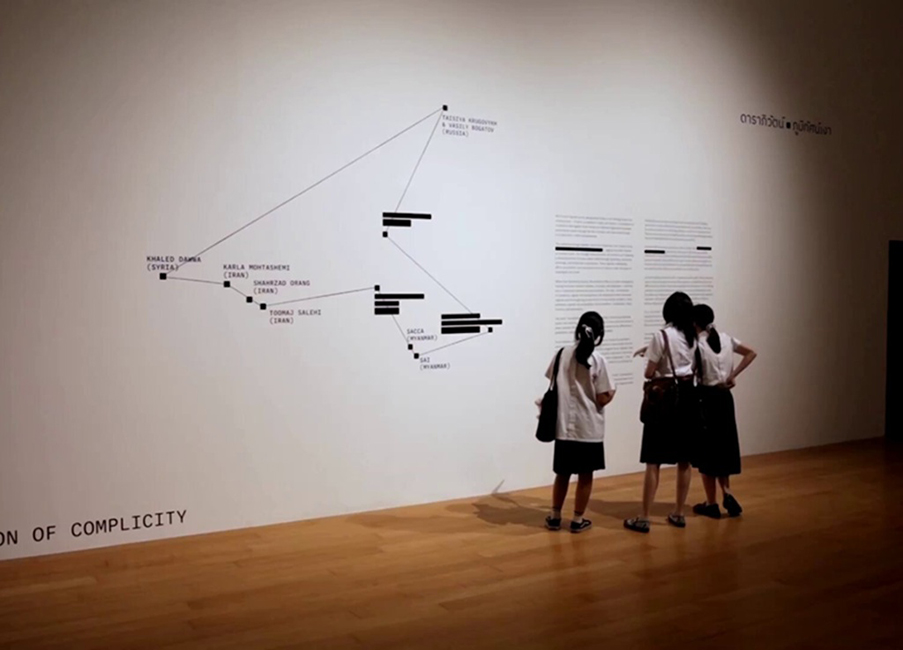(TibetanReview.net, Aug09’25) – An exhibition on authoritarian governments held in Thailand has been forced to remove materials about Beijing’s treatment of ethnic minorities and Hong Kong at China’s “request”, reported Reuters Aug 9. The move is seen as a reflection of the intensity of China’s transnational repression in the arts world.
The report said the Bangkok Art and Cultural Centre, which hosted the exhibit, changed multiple works by artists in exile in the exhibit on authoritarian governments collaborating across borders.
The report noted that on Aug 7, some works previously advertised and photographed had been removed, including a multimedia installation by a Tibetan artist, while other pieces had been altered, with the words “Hong Kong”, “Tibet” and “Uyghur” redacted, along with the names of the artists.
The exhibition also features works by artists in exile from Russia, Iran and Syria.
It all began three days after the show “Constellation of Complicity: Visualising the Global Machinery of Authoritarian Solidarity,” opened on Jul 24, when Chinese embassy staff, accompanied by Bangkok city officials, “entered the exhibition and demanded its shutdown”, the report cited the exhibit’s co-curator, Mr Sai, a Myanmar artist who goes by one name, as saying.
The report said that in a Jul 30 e-mail, the gallery had said: “Due to pressure from the Chinese Embassy – transmitted through the Ministry of Foreign Affairs and particularly the Bangkok Metropolitan Administration, our main supporter – we have been warned that the exhibition may risk creating diplomatic tensions between Thailand and China.”
The gallery has spoken of having “no choice but to make certain adjustments”, including obscuring the names of the Hong Kong, Tibetan and Uyghur artists.
Works withdrawn from the Bangkok exhibit by Tibetan artist Tenzin Mingyur Paldron were stated to include a video of Tibetans carrying Palestinian flags while calling for accountability for genocide and a film titled Listen To Indigenous People.

“By forcing (the gallery) to remove significant parts of my work, the Chinese government has once again demonstrated that it desperately wishes to cut Tibetans off from the rest of the world,” Mr Paldron has said, adding that China did not “want its complicity in other colonialisms and genocides to be recognised”.
“Who are museums for?” he has continued. “They should be for the people, not dictators of any ideology.”
Mr Sai has said that several days later, the embassy demanded further removals.
The Chinese embassy in Bangkok and foreign ministry in Beijing, and Thailand’s foreign ministry did not respond to multiple requests for comment, the report said.
Mr Sai, co-founder of the Myanmar Peace Museum, the organisation that put together the exhibition, has said the removed pieces included Tibetan and Uyghur flags and postcards featuring Chinese President Xi Jinping, as well as a postcard depicting links between China and Israel.
“It is tragically ironic that an exhibition on authoritarian cooperation has been censored under authoritarian pressure,” he has said.
Mr Sai himself had fled the country, saying Thai police sought to find him. However, the superintendent of the Pathumwan Police Station, who oversees the gallery’s Bangkok neighbourhood, has claimed to Reuters that he had received no reports of such an incident.
Thailand remains a dangerous place for people sought by Beijing. In 2025, it returned to China 40 Uyghurs, members of a mainly Muslim ethnic minority numbering about 10 million in the PRC’s far western region of Xinjiang, in a secretive deportation. This was despite the fact that UN experts had warned they would be at risk of torture, ill-treatment and “irreparable harm”.


